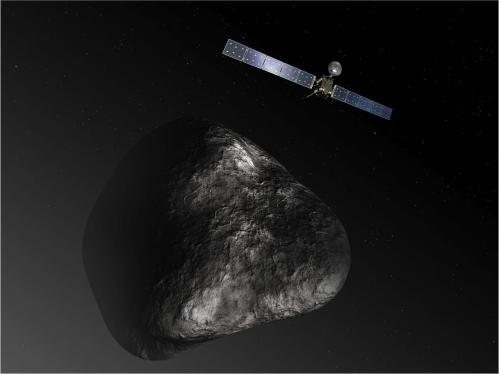
(Artist’s concept of Rosetta orbiting 67P – Photo Credit: NASA/ESA)
A NASA instrument aboard the European Space Agency’s Rosetta spacecraft has successfully obtained its first set of science data from comet 67P/Churyumov-Gerasimenko.
The instrument, named Alice, began mapping the comet’s surface in August by recording the first far-ultraviolet light spectra of the comet’s surface. From this data, the Alice team discovered that the comet is unusually dark, resembling charcoal, when viewed in ultraviolet wavelengths.
Rosetta scientists also discovered that the comet’s surface shows no large water-ice patches, so far. The team expected to see ice patches on the comet’s surface because it is too far away for the sun’s warmth to turn its water into vapor.
“We’re a bit surprised at just how unreflective the comet’s surface is and how little evidence of exposed water-ice it shows,” said Alan Stern, Alice principal investigator at the Southwest Research Institute.
Alice has been sent to comet 67P/Churyumov-Gerasimenko, aboard Rosetta, on a mission to probe the origin, composition and workings of the comet. It will also gather sensitive, high-resolution insights that cannot be obtained by both ground-based and Earth-orbiting observation.
It has more than 1,000 times the data-gathering capability of instruments flown a generation ago, yet it weighs less than nine pounds (four kilograms) and needs just four watts of power to operate. The instrument is one of two full instruments on board Rosetta that are funded by NASA.
Other U.S. contributions aboard the spacecraft are the Microwave Instrument for Rosetta Orbiter (MIRO), the Ion and Electron Sensor (IES), part of the Rosetta Plasma Consortium Suite, and the Double Focusing Mass Spectrometer (DFMS) electronics package for the Rosetta Orbiter Spectrometer for Ion Neutral Analysis (ROSINA). They are part of a suite of 11 total science instruments aboard Rosetta.
MIRO is designed to provide data on how gas and dust leave the surface of the nucleus to form the coma and tail that gives comets their distinctive beauty, while IES is part of a suite of five instruments that will analyse the plasma environment of the comet.